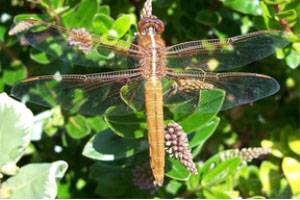The majority of flame skimmers seen near the water are males patrolling for females that are prepared to mate and lay eggs. Females tend to be more numerous away from water feeding on small insects caught on the wing in mid-air. Skirmishes between the territorial males are accentuated by an ascending "Red Baron� flight that can extend for up to five minutes before the victor claims the prime perching site.
Photo Credit: Eugene Zelenko
Libellula saturata
Common Name: flame skimmer
Other Common Names: big red skimmer, firecracker skimmer
Other Scientific Names: Belonia saturata
Animal Guild: Insect
Class > Order > Family: Insecta > Odonata > Libellulidae
What does the species look like?
Adult: This is a large, robust, orange-red western species. The thorax and abdomen are distinctly stocky. Wings have red veins and an amber patch and are held out flat, not downward, when at rest. The thorax lacks lateral stripes. Males’ bodies are entirely red or dark orange body. Their legs are red with black spurs. Most have red eyes, although some are brown-eyed. Females are paler than males usually medium or darker brown with some thin, yellow markings. Wings show only an orange stream along the leading wing edges with brown streaks near the base. A less common male-like form exists with much more red in the wings than typical females. Young individuals quickly become bright red with age. Total length: 1.97-2.36 inches (50-60 mm); abdomen: 1.26-1.57 inches (32-40 mm); hindwing: 1.61-1.77 inches (41-45 mm).|Similar Species: The neon skimmer, Libellula croceipennis, has red on the face, front of the thorax, and abdomen. The wing color does not extend beyond the nodus and is less prominent. It also lacks the darker brown stripe covering the midbasal space in the hindwing and the female has clear wings. The Mayan setwing, Dythemis maya, has a much more slender body. The golden-winged skimmer, Libellula auripennis, and Needham's skimmer, Libellula needhami, have a black mid-dorsal stripe running down the abdomen. Female and young roseate skimmers, Orthemis ferruginea, and orange-bellied skimmers, Orthemis discolor, both have white lateral thoracic markings. The cardinal meadowhawk, Sympetrum illodum, appears similar but often holds its wings down and forward.|Nymph: The nymph is fairly large (to 1.10 inches, or 28 mm), but still very difficult to differentiate from similar species. The form is large and chubby looking due to the rounded abdomen. The entire body is covered with hair but lacks hooks or spines. The abdomen is rounded, giving it a short stocky appearance (known as the sprawler form). Eyes occupy the front-lateral portion of the head. The margin of the median lobe of the labium is smooth or not evenly crenulated. Â
Where is the species found?
States & Provinces
AZ, CA, CO, ID, KS, MO, MT, NM, NV, OK, OR, SD, TX, UT, WY
Distribution
This species occurs in most states in the western half of the United States from Montana to Oregon, south to southern California, east to Texas, and north through Oklahoma, Kansas, and Wyoming. There are outlying records in Missouri and South Dakota and a disjunct population in Houston, Texas. The species also occurs in northern Mexico (Baja California, Chihuahua, Coahuila, Nuevo Leon, Oaxaca, and Sonora).
This species is typically found near warm water ponds, warm, slow streams, lakes, ditches, and hot springs- particularly in the northern part of its range. In Idaho, it occurs in high elevation deserts.
General Phenology and Life History
Breeding occurs from May to September Males compete for prime breeding spots and for females. Males often search long stretches of streams for potential mates. After copulation, the pair separates and the female oviposits (= lays eggs) alone by tossing water along with eggs in a direction towards shore. Males typically do not guard ovipositing females or only guard for short periods before departing. Flight period is from early June to late September in Oregon, February to December in California, early June to mid-September in Montana, and late April to late September in Texas.
Which phenophases should I observe?
Do you see/hear...?
Activity
Adults More...
For abundance, enter the number of individual animals observed in this phenophase.
Adults feeding Libellula saturata , adults feed on almost any flying insect they can catch.
For abundance, enter the number of individual animals observed in this phenophase.
Reproduction
Mating For abundance, enter the number of individual animals observed in this phenophase.
Egg laying For abundance, enter the number of individual animals observed in this phenophase.
Development
Recently emerged adults For abundance, enter the number of individual animals observed in this phenophase.
Dead adults For abundance, enter the number of individual animals observed in this phenophase.
Method
Individuals at a light For abundance, enter the number of individual animals observed in this phenophase.
Individuals in a net For abundance, enter the number of individual animals observed in this phenophase.
Individuals in a trap For abundance, enter the number of individual animals observed in this phenophase.
What do these phenophases look like?
There is currently no photoguide available for this species. If you'd like help us create one, use the guidance document and species template provided here . Then send it via email to education@usanpn.org when it is complete.
